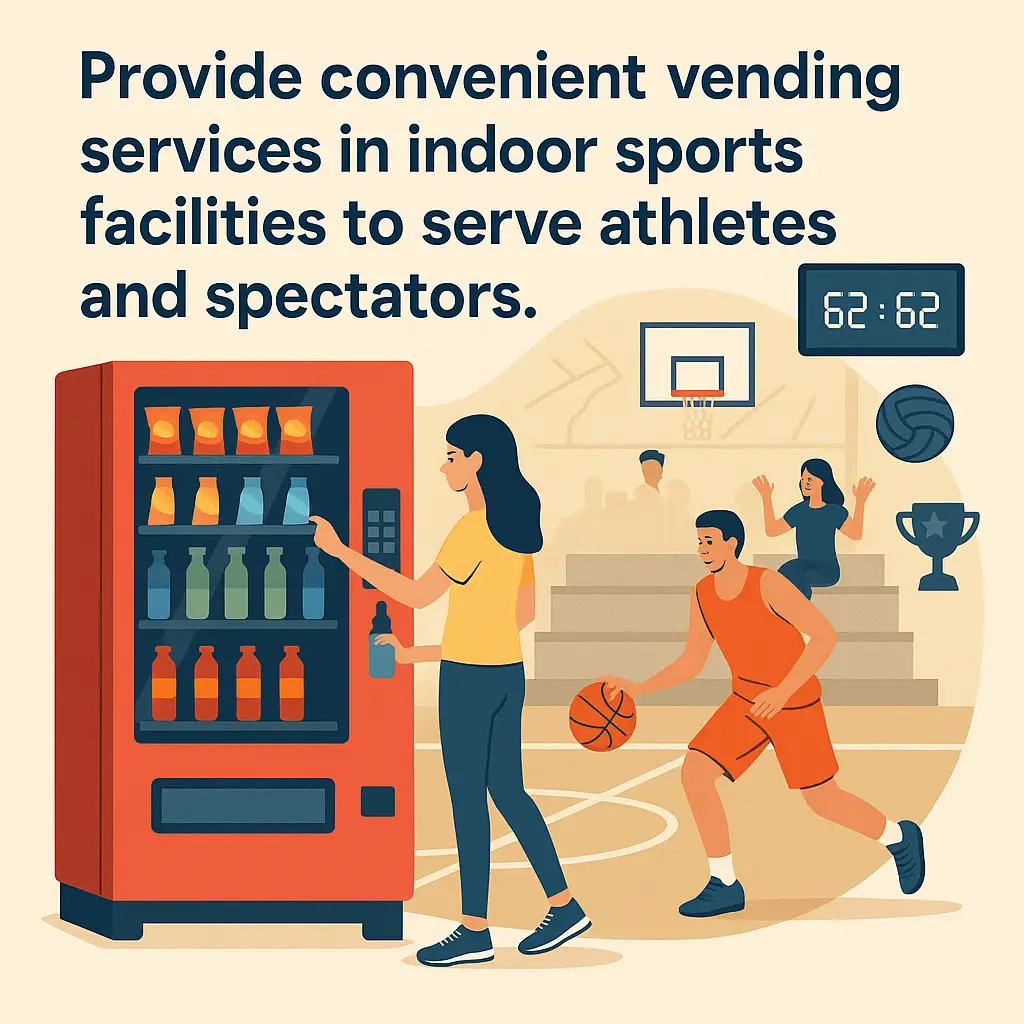Vending Machines in Indoor Sports Centers
Provide convenient vending services in indoor sports facilities to serve athletes and spectators.
Back to Vending for Entertainment Venues ResourcesProvide convenient vending services in indoor sports facilities to serve athletes and spectators.
Back to Vending for Entertainment Venues ResourcesBy offering quick hydration, energy-boosting snacks, and fast checkout, vending can support athletes and spectators without affecting facility operations.
![]() Easy access to water and sports drinks between games and practices
Easy access to water and sports drinks between games and practices
![]() Grab-and-go nutrition keeps athletes energized during tournaments and long sessions
Grab-and-go nutrition keeps athletes energized during tournaments and long sessions
![]() Contactless payments and smart inventory reduce lines and downtime
Contactless payments and smart inventory reduce lines and downtime

Indoor sports centers host players, coaches, and families who need fast access to hydration and snacks between practices, games, and tournaments. Full-service vending delivers a turnkey way to keep machines stocked and payments simple, allowing facilities to focus on programming and customer experience.
Athletes often need rapid access to water, electrolyte drinks, and recovery snacks. Spectators and visiting families appreciate family-friendly options and quicker checkout than traditional concessions during busy events. Stock selections that balance performance-oriented items with grab-and-go snacks make vending a practical complement to your concession operations.
Strategic placement—near entrances, lobby areas, spectator seating, and court-side corridors—ensures machines are convenient without obstructing foot traffic. During tournaments, machines located near registration desks or multi-court viewing areas can reduce lines and support high-volume demand. For broader strategies on placement in event spaces, see this guide to vending in entertainment venues.
Offering healthier snacks, low-sugar drinks, and clearly labeled items aligns with community wellness initiatives and meets the needs of youth athletes. Incorporating these options helps facilities support performance and parent preferences; learn more about healthy selections in public settings in this resource on healthy vending.
Cashless and mobile payment options speed transactions and reduce touchpoints during busy events. Modern machines can also report inventory levels and usage patterns, helping to schedule more frequent servicing around tournaments and peak hours. For examples of vending in multi-use public buildings, review this overview of vending for public buildings.
Vending installations require minimal facility modification and can be scaled to match event schedules. With efficient service models, restocking and maintenance are handled without adding to staff workload. To understand how full-service approaches simplify operations, see this explanation of full-service vending.
If you're evaluating vending for your indoor sports center, Vending Exchange can help plan placements, product mixes, and payment options to suit your facility's needs. Machines, stocking schedules, and servicing are coordinated to minimize impact on staff and maximize convenience for visitors—just fill out the form on this page to get started.
They provide fast access to hydration and snacks for athletes and spectators, improving convenience and satisfaction during events.
Bottled water, electrolyte drinks, protein and granola bars, and quick family-friendly snacks tend to sell best.
Lobbies, near registration desks, by spectator seating, and in corridors between courts are effective locations.
Yes. Machines can be stocked with sports drinks, electrolyte options, and bottled water for quick rehydration.
Absolutely. Low-sugar, high-protein, and clearly labeled allergen-friendly choices can be provided.
Yes. Service frequency and inventory levels can be adjusted seasonally or for specific events to meet demand.
Most machines accept cards, contactless, and mobile wallets, enabling fast, touch-free purchases.
No. Installations typically need only floor space and access to power—no major construction is required.
Restocking and service schedules are coordinated to reduce staff involvement and keep machines operational.
Most installations are completed within days to a week, depending on machine selection and site readiness.